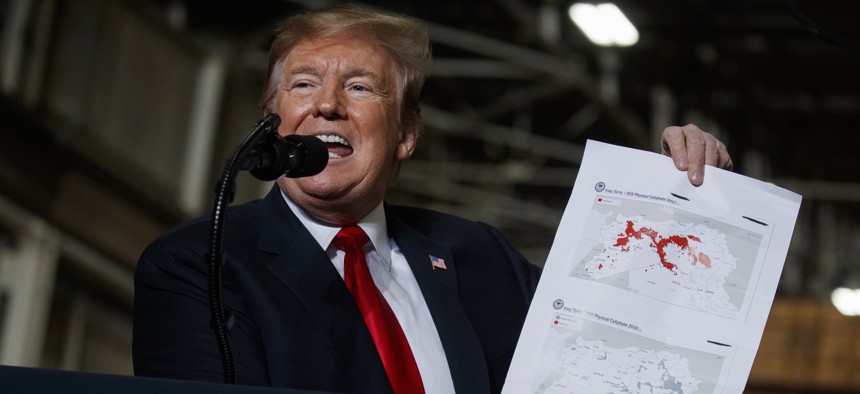
President Donald Trump holds up a chart documenting ISIS land loss in Iraq and Syria as delivers remarks at the Lima Army Tank Plant, Wednesday, March 20, 2019, in Lima, Ohio. AP Photo/Evan Vucci
The ‘Caliphate’ Is Dead, but Americans Might Not Be Any Safer
Why a terrorist group with land looked so threatening to the United States.
The Islamic State is gone, even if only in strict geographic terms. Once estimated to span territory up to about the size of Maine, the group’s self-declared caliphate in Iraq and Syria has disappeared entirely in less than five years. As of early February, the group held just about a square mile on the Syrian border, and though the final assault took six weeks, the U.S.-backed Kurdish forces conducting the operations announced the collapse on Saturday.
The collapse is a major achievement for the U.S. and its allies, even though it won’t stop the group from conducting attacks in the region or inspiring them overseas. At its peak strength in 2014 and 2015, ISIS was considered unique among terrorist organizations for controlling so much territory. But that very distinction underscored how terrorist groups throughout history have waged violence perfectly well without states of their own. So why did territory in particular help make ISIS look so threatening to the United States? And is America safer now that the “caliphate” has fallen?
“I remember seeing the pictures of locations in … al-Anbar province, in particular in Fallujah, where I’d actually fought, with the black flag flying over them,” says John R. Allen, the retired Marine general who helped organize the coalition to defeat ISIS during the Obama administration. “And it had largely all happened under our visible horizon, off the radar.” At that point, early in 2014, officials tended to see the group as focused on local power struggles, not on attacking the United States. But even as President Barack Obama infamously compared ISIS to a “JV team,” its local power kept spreading.
As ISIS accumulated territory, the Obama administration engaged in a wrenching debate about whether to again commit the American military to Iraq, a country it had quit just a few years before. The scale of the Islamic State’s abuses—the sex slavery, the violent enforcement of its interpretation of Islamic law, the mass executions—was growing clearer, but it was still obscure.
Meanwhile, there were also indications that the group could use its territory to plot attacks against Western targets, but that still didn’t necessarily mean it would succeed. Decades of debate before ISIS had brought no consensus on how important territory really is to terrorist groups. The deadliest terrorist attack in American history, on September 11, 2001, had been largely planned from a safe haven in Afghanistan; the second-most-fatal, the Oklahoma City bombing, had been planned in the United States.
ISIS also wasn’t the first group to use terrorism and then control territory; the terrorism scholar Bruce Hoffman pointed out that many groups, from the Communists in China after World War II to the Vietcong in Vietnam to the FARC in Colombia, had operated along a spectrum of violence, from terrorist attacks on civilians to massing forces for guerrilla-style attacks to mass mobilization into an insurgent group that could hold territory. Where ISIS differed, Hoffman told me, was mainly in how quickly it moved through this process—even as it kept up its campaign of terrorism against civilians.
By the summer of 2014, ISIS was routing entire Iraqi army divisions, some of which simply “evaporated” rather than fight, Allen says. The group had taken over one of Iraq’s largest cities, Mosul, where its leader, Abu Bakr al-Baghdadi, declared a caliphate. The fall of the Iraqi capital of Baghdad to the militants seemed like a real possibility. The group aimed to seem irresistible and invincible, Allen says. And they were turning their attention toward Iraq’s northern Kurdish enclave. U.S. officials began to worry that the group could overrun the Kurds, who had been some of America’s best partners in Iraq. The officials were also horrified by the humanitarian catastrophe unfolding on Iraqi Kurdistan’s Mount Sinjar, where the group had besieged members of the Yazidi religious minority.
The territory ISIS had amassed, meanwhile, gave the group freedom to maneuver, access to financial resources, and a powerful recruitment tool for thousands of foreign fighters seeking a physical place to live and fight for their version of Islam. There was a growing sense within the administration that the more the group was allowed to expand, the harder it would be to dislodge.
ISIS had seized banks and oil refineries; it was also generating income by taxing the population in the areas under its control. By one estimate, these sources added up to revenues of more than $800 million for the group in 2015. Launching terrorist attacks is cheap—sometimes it’s just the cost of a car rental. And the more resources ISIS had, the more damage it could potentially inflict. Not just with guns and U-Hauls—Hoffman pointed out that early on, the group seized the University of Mosul, where it conducted research on chemical weapons. Al-Qaeda had done similar research at facilities in Afghanistan.
Finally, though, there was the ideological appeal of establishing a “caliphate,” a supposed holy land that the group’s adherents argued Muslims around the world were duty-bound to defend and expand. It was partly this project that drew so many thousands of foreigners to Iraq and Syria—not just to fight, but also to help administer the newly declared “state.” The entity’s very existence looked like a powerful statement, not only that ISIS could threaten the most powerful military on Earth, but also that it had succeeded in remaking the map of the Middle East.
ISIS managed to carry out some audacious attacks abroad, such as the combined bombing and shooting spree in Paris, planned from the caliphate’s self-declared capital in Raqqa, Syria, that killed about 130 people. But the West’s worst fear—of multiple Paris-style attacks carried out in different countries simultaneously by foreign fighters sent back home—did not happen. In the United States and Europe, it was far more typical for individuals with only online connections to ISIS, if any, to stage attacks in the group’s name. These, too, could kill in large numbers, like the 2016 truck attack in Nice that killed more than 80 people, or the shooting in Orlando that same year that killed 50. The overwhelming majority of the group’s victims, though, were not in the West; they were mainly the Iraqis and Syrians living under its control, who have died by the thousands at the group’s hands since 2014. Over 1,000, and perhaps thousands, more people have died in the coalition campaign against the group (there is a wide discrepancy between official and independent estimates).
As ISIS’s core territory has collapsed, so has the group’s prowess in other realms. The Islamic State’s propaganda output has diminished with the destruction of some of its media centers in Syria. The flow of foreign fighters to the shrinking territory has slowed dramatically. The number of deaths in attacks claimed by the group worldwide has declined steadily since its peak in 2014. The deadliest recent attack the group has claimed against a Western target was in August 2017, when a van struck pedestrians in Barcelona, killing 13 people.
Yet the group continues to stage massive suicide bombings in Iraq, Syria, and elsewhere—in late January, it claimed responsibility for a suicide bombing that killed 20 people in Indonesia. It maintains eight declared branches in countries around the world; estimates from the Pentagon and the United Nations routinely place its fighting force at up to 30,000, which isn’t much of a change from the CIA estimate of ISIS fighters in 2014, though it’s difficult to put a precise figure on the fighting force. The group’s production of new propaganda may have slowed down, but there’s plenty out there already for any interested zealot with an internet connection. If someone wants to drive a car into a crowd and claim that ISIS made him do it, it’s no easier stopping him today than it was yesterday.
“We know right now that there are ISIS fighters scattered still around Syria and Iraq, and that ISIS itself is growing in other parts of the world,” National Security Adviser John Bolton told ABC earlier this month. “The ISIS threat will remain.”
Allen likens ISIS to a “three-headed monster”: core ISIS in Iraq and Syria, the eight ISIS provinces, and digital ISIS. With one of the heads gone, the question is how the other heads will react. “Does a defeat mean that people are less attracted to [ISIS] because it’s no longer the winning trend, or does it imply that people are going to want to take revenge?” asks Rob Malley, who served as Obama’s senior adviser on countering ISIS. “I would suspect that there is perhaps a lesser ability to get people to be motivated when the caliphate is defeated.”
But ISIS itself grew out of previous supposed defeats of insurgent groups in Iraq, and it’s not clear how long this particular defeat will last. A recent report to Congress warned that “conditions are ripe for extremists to return to Mosul,” which remains largely decimated more than a year after Iraq’s then–prime minister declared it freed from the Islamic State’s grip. The Shiite-led Iraqi government is engaged in some of the same kinds of reprisals against the Sunni population that stimulated the rise of ISIS in the first place. The report noted, of recent counterterrorism campaigns in Iraq, Syria, Somalia, Libya, Yemen, Nigeria, and Mali: Following “each supposed defeat, extremist groups return having grown increasingly ambitious, innovative, and deadly.”
NEXT STORY: All ISIS Has Left Is Money. Lots of It.



